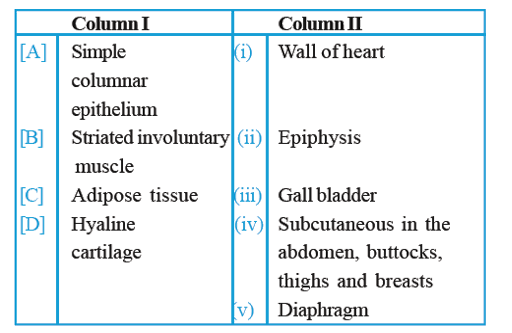Match column I with column II and select the correct option from the codes given below.
A-(iv), B-(iii), C-(i), D-(ii)
The correct Answer is:B
To solve the matching question between Column I and Column II, we will analyze each term in Column I and find its corresponding match in Column II.
1. Match Acrosome:
- The acrosome is a cap-like structure present on the head of the sperm (spermatozoon). It contains enzymes that help the sperm penetrate the egg during fertilization.
- Match: A. Acrosome → (iv) Spermatozoon
2. Match Endometrium:
- The endometrium is the innermost layer of the uterus, which thickens and sheds during the menstrual cycle. It is crucial for implantation of the embryo.
- Match: B. Endometrium → (ii) Uterus
3. Match Polar Body:
- Polar bodies are small cells that are produced during oogenesis (the formation of eggs) and are a result of meiotic divisions in the ovaries.
- Match: C. Polar Body → (iii) Oogenesis
4. Match Clitoris:
- The clitoris is a small, sensitive organ in the female reproductive system, considered rudimentary erectile tissue, analogous to the penis in males.
- Match: D. Clitoris → (i) Rudimentary erectile tissue
Final Matches:
- A → (iv) Spermatozoon
- B → (ii) Uterus
- C → (iii) Oogenesis
- D → (i) Rudimentary erectile tissue
Correct Option:
From the matches, we can conclude that the correct option is B, where all terms have been matched correctly.
---
- The acrosome is a cap-like structure present on the head of the sperm (spermatozoon). It contains enzymes that help the sperm penetrate the egg during fertilization.
- Match: A. Acrosome → (iv) Spermatozoon
- The endometrium is the innermost layer of the uterus, which thickens and sheds during the menstrual cycle. It is crucial for implantation of the embryo.
- Match: B. Endometrium → (ii) Uterus
- Polar bodies are small cells that are produced during oogenesis (the formation of eggs) and are a result of meiotic divisions in the ovaries.
- Match: C. Polar Body → (iii) Oogenesis
- The clitoris is a small, sensitive organ in the female reproductive system, considered rudimentary erectile tissue, analogous to the penis in males.
- Match: D. Clitoris → (i) Rudimentary erectile tissue
- A → (iv) Spermatozoon
- B → (ii) Uterus
- C → (iii) Oogenesis
- D → (i) Rudimentary erectile tissue
From the matches, we can conclude that the correct option is B, where all terms have been matched correctly.
Similar Questions
Match Column I with Column II and select correct option from the codes given below.
 View Solution
View SolutionMatch column I with column II and select the correct option from the codes given below.
Column IColumn IIA.Dictyosomes(i)StorageB.Mitochondria(ii)PhotosynthesisC.Vacuoles(iv)TransportD.Grana(iv)Secretion(v)RespirationView Solution
Knowledge Check
- Question 1 - Select One
Match column I with II column II and select the correct option from the given codes .
 AA-(ii), B-(iii), C-(iv), D-(i)BA-(iii), B-(ii), C-(i), D-(iv)CA-(iii), B-(ii), C-(iv), D-(i)DA-(i), B-(ii), C-(iii), D-(iv)
AA-(ii), B-(iii), C-(iv), D-(i)BA-(iii), B-(ii), C-(i), D-(iv)CA-(iii), B-(ii), C-(iv), D-(i)DA-(i), B-(ii), C-(iii), D-(iv) - Question 2 - Select One
Mathc column I with column II and select the correct option from the given codes.
 AA-(ii), B-(iii), C-(iv), D-(i), E-(v)BA-(v), B-(iv), C-(iii), D-(i), E-(ii)CA-(i), B-(iii), C-(iv), D-(ii), E-(v)DA-(i), B-(iv), C-(iii), D-(ii), E-(v)
AA-(ii), B-(iii), C-(iv), D-(i), E-(v)BA-(v), B-(iv), C-(iii), D-(i), E-(ii)CA-(i), B-(iii), C-(iv), D-(ii), E-(v)DA-(i), B-(iv), C-(iii), D-(ii), E-(v) - Question 3 - Select One
Mathc column I with column II and select the correct option from the given codes.
 AA-(iii),B-(v), C-(iv),D-(ii)BA-(ii),B-(iv),C-(v),D-(i)CA-(ii),B-(iv),C-(v),D-(iii)DA-(iii), B-(v), C-(iv), D-(i)
AA-(iii),B-(v), C-(iv),D-(ii)BA-(ii),B-(iv),C-(v),D-(i)CA-(ii),B-(iv),C-(v),D-(iii)DA-(iii), B-(v), C-(iv), D-(i)
Match column I with column II and select the correct option from the codes given below.
Column IColumn IIA.Mitochondria(i)Without membraneB.Lysosomes(ii)Single membraneC.Ribosomes(iii)Double membraneD.NucleusView SolutionMatch column I with column II and select the correct option from the codes given below.
Column IColumn IIA.Planaria(i)Binary fissionB.Fungi(ii)Asexual sporesC.Yeast(iii)BuddingD.Amoeba(iv)True regeneration(v)FragmentationView SolutionMatch column I with column II and select the correct option from the codes given below
Column IColumn IIA.Choanocytes(i)PlatyhelminthesB.Chindoblasts(ii)CtenophoraC.Flame cells(iii)PoriferaD.Nephridia(iv)CoelenterataE.Comb plates(v)AnnelidaView SolutionMatch column I and II and select the correct option from the given codes.
 View Solution
View SolutionMatch column I with column II and select the correct option from the codes given below.
Column IColumn IIA.Rhizopus(i)AscomycetesB.Penicillium(ii)BasidiomycetesC.Ustilago(iii)DeuteromycetesD.Alternaria(iv)PhycomycetesView Solution

